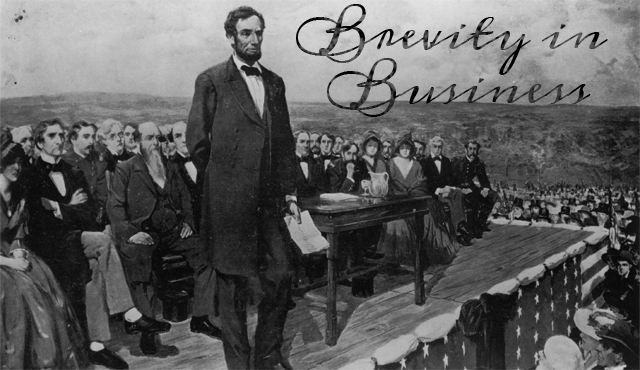When entering junior high, studying a foreign language became an…

Brevity in Business
We’ve all heard the expression “less is more”, but it perhaps was most clear on a hot, July day in 1863 in Gettysburg Pennsylvania, when two men were asked to speak in the aftermath of one of the most historic and costly battles of American history.
The first was the venerable Edward Everett, the nation’s foremost rhetorician, who was chosen to give an oration at the dedication ceremony. The other, of course, was President Lincoln. Mr. Everett spoke for two hours. In stark contrast to that forgotten oration, President Lincoln stood for two minutes and gave one of the most memorable and shortest speeches of all time. As he finished, the audience what so surprised that the silence was deafening to Lincoln and he feared that he had failed in his purpose. Time has shown differently.
In a letter to President Lincoln, Everett wrote “I should be glad to flatter myself that I came as near to the central idea of the occasion in two hours as you did in two minutes.”
Everett did not say that Lincoln covered the topic better or more in-depth. I’m sure Everett performed much better in that respect, but as we can all recite elements of Lincoln’s famous speech, we can see that, while what is said is important, that which is remembered is all the more so.
While in business school, we were taught to write mission statements that covered all the bases and were paragraphs long. I am encouraged that there has been a trend to simplify and shorten mission statements and other documents. Unfortunately, while many have simplified, many others have continued to over complicate, weigh down and word up. Richard Branson sums up a great mission statement:
“Brevity is certainly key, so try using Twitter’s 140-character template when you’re drafting your inspirational message. You need to explain your company’s purpose and outline expectations for internal and external clients alike. Make it unique to your company, make it memorable, keep it real and, just for fun, imagine it on the bottom of a coat of arms.”
Let’s be more deliberate, more meaningful and, of course… more less.
Next Post: Considering a Logo Redesign
Previous Post: Marketers are Evil

